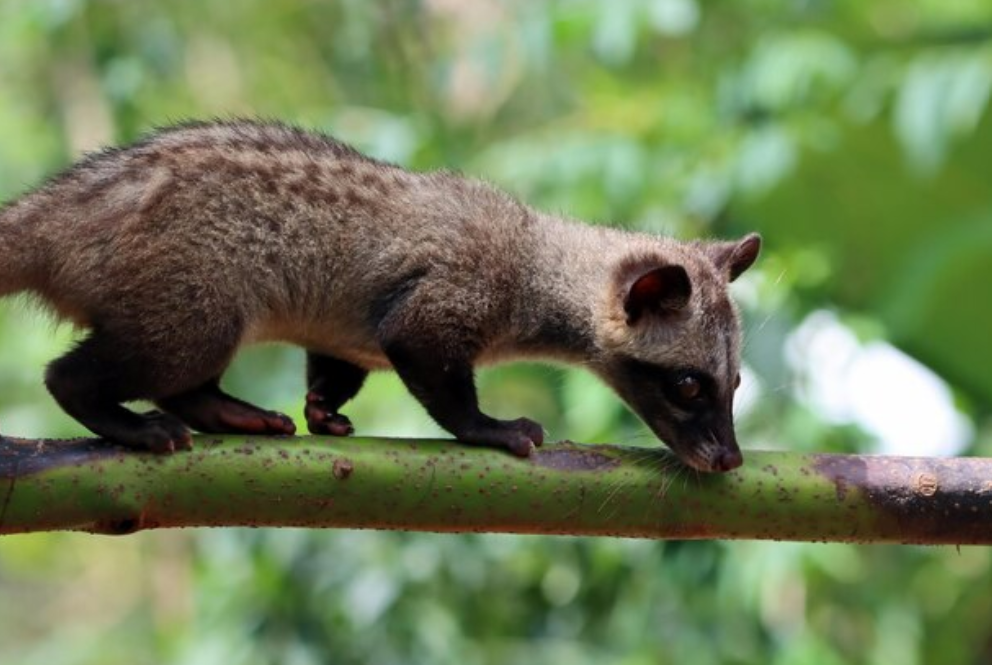
Introduction of the African Palm Civet and its native habitat in Africa
Known by its scientific name, Nandinia binotata, the African palm civet is a tiny animal that is indigenous to Africa’s rainforests. Its long tail, keen claws, and thin body are its defining features. In contrast to other civet species, the African Palm Civet has a special adaptation that makes it easy for it to climb palm trees. Its capacity to eat largely fruits and foliage from the top canopy of these trees is essential to its survival.
Ability to consume palm fruits and the role it plays in seed dispersal
The African palm civet plays an intriguing role in seed dispersion. Throughout the jungle, the civet eats a variety of fruits, breaking down the pulp but retaining the seeds whole. Plant germination and spread are facilitated by the excretion of these seeds in various areas. The civet and the plants it eats have a symbiotic connection that is vital to the rainforest ecosystem’s biodiversity.
Nocturnal habits and adaptations for nighttime activities
The nocturnal lifestyle of the African palm civet is another amazing feature. It uses its great sense of smell and night vision to navigate its environment, since it is mostly active at night. In doing so, the civet is able to identify its favourite food sources and steer clear of any predators. The civet is also renowned for its lonesome disposition, preferring to live and hunt by itself. By acting in this way, the civet preserves its environment and lessens competition for resources.
Interesting facts about the African Palm Civet
A little animal that is a member of the Viverridae family, the African palm civet is also known as Nandinia binotata. Its unusual look and intriguing actions have made it a household name in Africa’s tropical woods. The African Palm Civet is intriguing, as shown by these facts:
1. Physical appearance of the African Palm Civet
With a long tail and a thin build, the African Palm Civet is around the size of a house cat. Its short ears, keen claws, and pointy nose are all characteristic. Greyish-brown to reddish-brown, its fur is thick and varies in hue. The black-and-white mask-like facial characteristics of the civet are its most characteristic.
2. Typical habitat preferences of the African Palm Civet
Sub-Saharan Africa’s lush flora and rainforests are home to these civets, principally. Along with the availability of water sources, they like habitats that are mixed with shrubs, trees, and ground cover. Given their arboreal lifestyle, African palm civets spend a significant portion of their time in trees, where they construct nests and forage for food.
3. Insights into the African Palm Civet’s diet
Nigerian Palm Diet Civets consume both plant material and small animals since they are omnivores. They eat eggs, tiny animals, birds, reptiles, berries, insects, and small mammals. What gives them their name is that they are especially fond of the fruit of the African oil palm. Through their consumption of fruits and their excretion of undigested seeds in various regions, civets play a crucial role in seed dispersion.
4. Nocturnal Behaviour of the African Palm Civet
Generally nocturnal or most active at night, the African palm civet lives in the shadows. To find and navigate, it uses its acute sense of hearing and smell, in addition to its outstanding night vision, to find prey. These very well-camouflaged civets spend the day sleeping in tree hollows or thickets.
5. Solitary nature, with individuals primarily living and foraging alone
Save for the time of year when they mate, African palm civets live alone. They use smell glands to mark their territory and use vocalisations like growls, hisses, and screams to communicate with one another. Compared to females, males have greater territories, which they will protect against intruders.
6. Unique reproductive behaviour of the African Palm Civet
60 to 70 days are needed for the gestation period in female African palm civets. Two to four blind and defenceless young are born in each litter that they give birth to. Before the young are left to fend for themselves, the mother tends to them. About a year of age marks the offspring’s sexual maturation.

7. Conservation status of the African Palm Civet
The International Union for Conservation of Nature (IUCN) now lists the African Palm Civet as a species of “Least Concern.” Their population is seriously threatened by habitat loss and deforestation, however. There are several areas where civets are hunted for their flesh and fur.
8. Ecological Importance of the African Palm Civet
The equilibrium of their ecosystems is maintained in large part by African palm civets. They contribute to the general well-being of the forest by spreading seeds and regulating insect populations. A thriving and varied environment is indicated by their existence.
The African palm civet is an amazing animal with unusual physical traits and activities. In the African rainforests, it plays a significant role in both seed distribution and ecological equilibrium. To ensure their long-term existence, efforts must be made to preserve their ecosystems and increase public understanding of conservation issues.